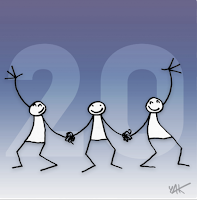Falling While Running
My worst fall, by far, happened when I WASN’T running! I was walking on a sunny day when I stepped on some acorns, my feet went out from under me and I fell backwards. I knew immediately it was bad - the plastic water bottle in my day pack was crushed, I couldn’t move my right arm, and all I could see were zig-zag rainbows. After two surgeries, an external fixator, and physical therapy I have regained use of my right arm and hand.
Then last month I was running when my toe caught on a raised crack in the street. All I could think was “Protect the arm!” So I turned to my left and impacted the ground with my left knee and palm, with just some slight scraping on my right knee and palm. My right arm was still intact! But my new capris were ripped in the knee and I was bloody. I got up, shrugged, turned around and ran home. As I passed other runners, I waved halfheartedly so they wouldn’t be grossed out by the blood dripping off my palms.
I have fallen many times while running over the years. Most people assume it is because I am an early morning runner and often run (with a headlamp) before the sun rises. The one time I tried running in the afternoon was years ago, when I was stationed at Keesler AFB. I was running along Chappie James Blvd when suddenly a sidewalk crack snagged me and I fell. Two MPs ran across the street to see if I was alright. I was burning with embarrassment! Falls can happen at any time of day or night. I will stick to my early morning running routine when there's less chance of embarrassing myself.
But I am not the only one falling! In one NIH study of 10,615 participants aged 20–87 years, 20% reported falling during the past year. Of those falling, 54% fell during sports or exercise. Another study reported that of those who had falls, 86.7% were walking while 11.1% were either sitting (?!) or running when they fell! At least I haven’t fallen out of a chair … yet.
Falling every once in a while will probably continue to be part of my running experience. I consider my scars part of my life story and reminders of the many times I fell down, got up, and kept on running.
Everyone has the right to life, liberty and security of person:
Walkable (and “runnable”) neighborhoods have long been prized among urban designers and residents. Walkability is linked to benefits including higher property values, less crime and better health among residents. For example, one recent study found that older adults living in easy-to-walk communities not only had better physical health, but also higher cognitive functions.
According to sociologist Robert A. Bullard, “The health benefits of walking are so overwhelming that to deny access to that is a violation of fundamental human rights. All communities should have a right to a safe, sustainable, healthy, just, walkable community.”
Everyone has the right to freedom of peaceful assembly and association:
Another study found that walkable neighborhoods are associated with higher levels of civic engagement. "The exercise of democracy begins as exercise, as walking around, becoming familiar with the streets, comfortable with strangers, able to imagine your own body as powerful and expressive rather than a pawn. People who are at home in their civic space preserve the power to protest and revolt, whereas those who have been sequestered into private space do not.”
Walkability is a sign of a strong democracy and is essential to the basic human right to freely assemble in public spaces. Dictators know that democracy must be exercised, regularly and on foot. So they restrict or eliminate public spaces, forbid public gatherings, and use force to break up protest walks.
Increasingly “democratic” governments are fencing off public spaces and placing barricades on public walkways which effectively force citizens out of civic areas. This retreat deprives us of the opportunity to see fellow citizens, converse with them and, perhaps, discover common concerns. Being able to walk in accessible, public spaces is a key way to uphold democratic rule, fair and free elections, cooperative conduct, and individual and minority rights.

The Exercise of Democracy:
Democracy is fragile and therefore needs to be reinvented every day in small acts as well as huge movements. Even when there are no “big issues” to galvanize action, walking itself can be a powerful way for people to commit to civic conduct as they move through their community and engage with others on public walkways. Walking provides a series of difficult and delightful experiences that invite you to think, feel, and be alive to possibility. People are noticing you and you are noticing them. You feel healthier; you are contributing to the microclimate of your community and encountering new opportunities for participation in democratic action.
Democratic life is about learning how to respectfully challenge oneself and others to improve the common good by balancing individual and collective interests. The first step - walk in your community. Walking literally puts you in touch with public spaces and community members. If you find that your community is not walkable, perhaps this is your opportunity to engage in microdemocracy. The exercise of democracy begins with one step.




